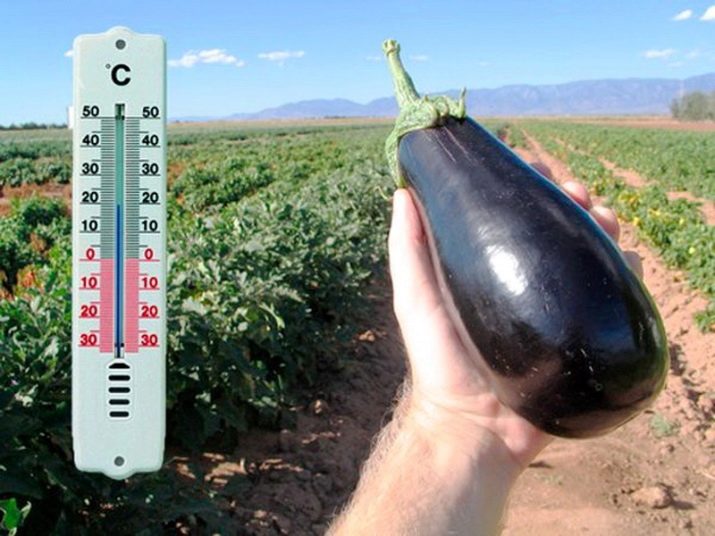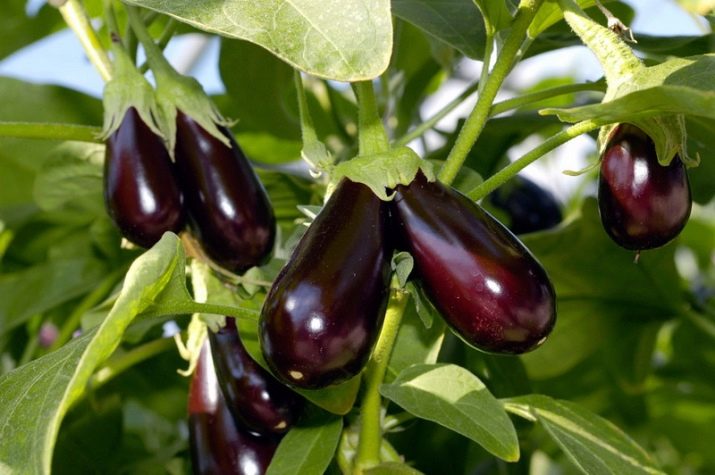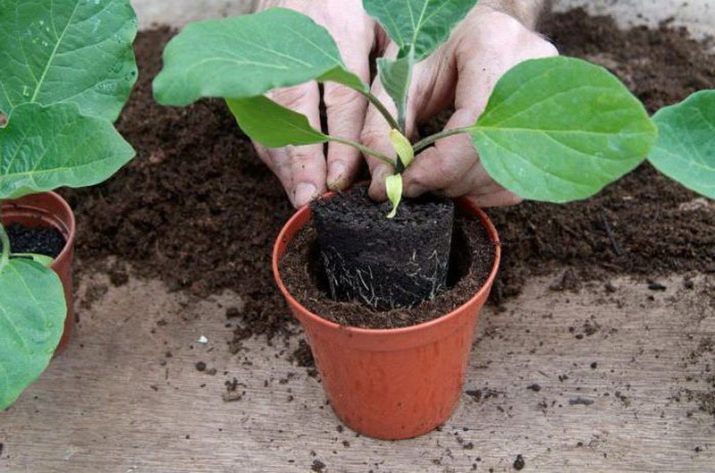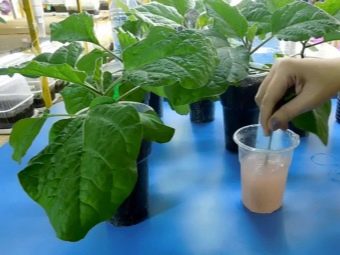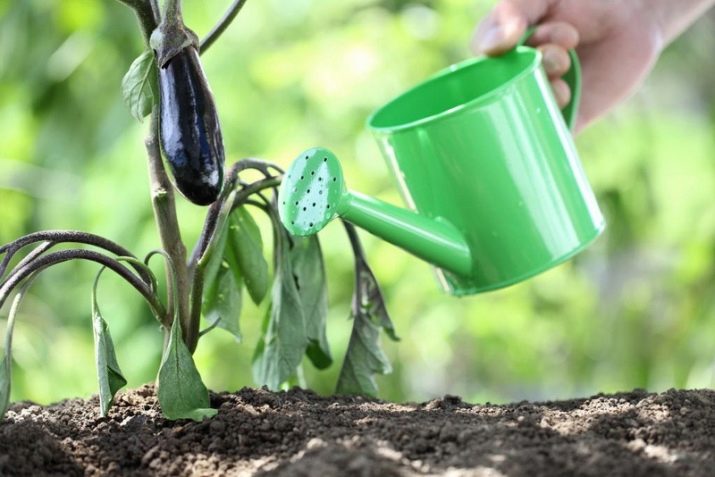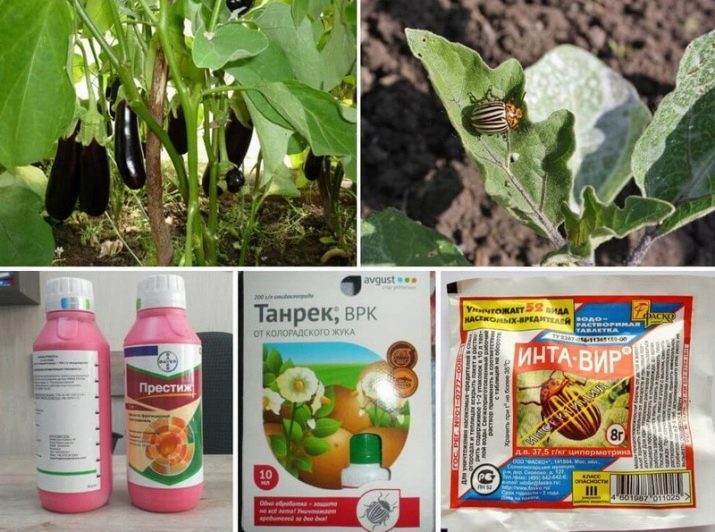Growing eggplant in open field
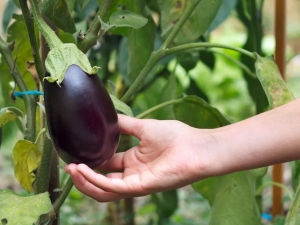
Eggplants are one of the most common plants among summer residents.This is one of the most welcome guests on our table, but not every gardener can make friends with him. The problem is that growing these fruits is difficult enough, because you need to pay close attention to them, constantly monitor the temperature and state of the external environment. Only in this case, you can grow the perfect product that will have a unique taste.
Features of culture
Eggplant is a southern culture, so the process of planting them in our harsh conditions is quite complicated and problematic. However, if you correctly select the variety, and also strictly follow the rules and recommendations, you can get high-quality and tasty vegetables. The homeland of this vegetable is India and Burma. In addition, they are quite in great demand in the southern regions of Europe and Asia, as well as in Africa. In domestic conditions, eggplant crops are large enough, since we love this vegetable and pay tribute to it on our table.
Given the fact that eggplants come from tropical areas, they love heat very much. And in order to obtain the highest quality and high yield, it is necessary to grow vegetables in high temperature conditions. A distinctive feature of this plant is that it can be grown in both open and closed ground. It is worth noting that eggplant is a perennial plant.
In other words, they can grow until the temperature of the soil at night falls below 10 degrees Celsius. Summer residents call the optimum temperature more than 25 degrees, when the eggplant receives the necessary amount of heat, which greatly reduces the growing season. If the air temperature is below 15 degrees, then the development occurs rather slowly, and at a temperature below 5 degrees the vegetable stops growing at all.
If the air temperature does not rise 24 hours above 5 degrees Celsius, the flowering stops and the vegetable dies completely, as the crops do not withstand such cold weather. It should be noted that extremely high temperatures also have a detrimental effect on eggplants.
That is why gardeners recommend growing this plant only in those regions where the air temperature does not rise above 40 degrees.
Like most other plants, Eggplants do not like sudden changes in temperature, which have a detrimental effect on the length of the growing season. Eggplants are characterized by a rather weak root system, therefore constant temperature fluctuations can lead to the death of the crop. That is why with sharp frosts and a decrease in temperature, it is necessary to immediately provide shelter for plants, because otherwise the crop will be completely spoiled.
For successful growth, these vegetables need to receive a sufficient amount of sunlight throughout their growing season. And if the light is not enough, the plant will react very aggressively. Initially, it is pulled out, after which it stops growing. A distinctive feature of eggplants is that there is no need for shading the plants, as this also has a negative impact on their growth. They can become brittle, and the appearance of the fruit will be delayed for several weeks, which will certainly affect the taste properties of the product.
For a good harvest, it is best to plant eggplants in regions where the soil receives sunlight throughout the day.
Eggplant is characterized by demands not only to air temperature, but also to the state of the soil, and to be more precise, only to its water and nutrient regime. It is best to choose fertile soils for sowing, which are distinguished by a sufficient level of acidity and moisture.Such vegetables react quite well to the use of humus and rotted manure. In addition, compost can be used to improve the yield.
Due to its unique root system, eggplants can penetrate into the soil up to one and a half meters, which makes them vulnerable to temperature changes and lack of moisture. As noted This culture is extremely poor at low and extremely high temperatures.therefore, these indicators need to be closely monitored. If you live in regions where it is not possible to do this, then it is best to use white varieties that are resistant to similar problems.
Professional gardeners advise growing eggplants only in good irrigation conditions. If there is too much rainfall in the region, it is necessary to prevent soil compaction. It must be constantly cleaned up, especially after rainy days.
Eggplants need water all the time, so watering should be given special attention. Even a temporary drying can cause a fall of the buds and the complete destruction of the crop. In addition, lack of moisture leads to depletion of plants, as a result of which they become vulnerable to the effects of pathogens and pests. In cold cloudy weather, it is necessary to monitor the level of humidity so that it does not exceed the required level.
Eggplants can be grown from seeds in a pot or immediately in the soil. It is rather difficult to plant a vegetable, which must be constantly monitored to prevent the spread of diseases or pests. Regular weeding, hilling and dressing will allow you to get a high-quality harvest in large quantities. It should be noted that eggplant seeds are characterized by an extremely long period of ripening.
Usually the ripening period is about two months. Professional gardeners claim that the most suitable place for growing eggplants are areas that are well lit and protected from the wind. It is better to plant this crop in the soil where cucumbers or legumes have previously huddled.
Choosing the right variety
The quality of the harvest depends not only on the characteristics of planting and climatic conditions in the region, but also on the literacy of choosing a particular variety. On the modern market there is a huge number of eggplant varieties that can be grown on the summer cottage. Considering the fact that domestic weather conditions for this vegetable are not considered native, it can be grown without difficulty only in the southern regions of the country. Here it is best to pick up early varieties.
As for the northern parts of our state, eggplants can be grown here only in greenhouse conditions. Of course, varieties for the Urals and Siberia are unlikely to be suitable for use in the Moscow region or Leningrad region.
It should be remembered that half of the success is just to choose the right variety for your conditions. One of the most popular and sought-after on the market is Almaz, which is characterized by an extremely high immune system and the ability to tolerate cold summers. In addition, the distinctive advantages of this variety are in its ability to cope with temperature changes. The fruits are pear-shaped and have a classic purple color. As for the mass of one fruit, it can reach 150 g.
Another popular variety is the "Behemoth", which is a fairly high-yielding option. Its main advantage is that the fruits are quite large and can reach a mass of 300 g. In addition, they are famous for their resistance to most local diseases, which greatly simplifies the process of caring for them.Even in the conditions of a short summer, these fruits ripen successfully and are distinguished by extremely unique taste qualities.
The grade of an eggplant known as "Matrosok" is characterized by unpretentiousness and high productivity. Such a vegetable can be grown only in high temperature conditions, therefore it is suitable only for the southern regions. Among its characteristic features can be distinguished thin skin and the absence of any bitterness, making the product suitable for use in raw form, for example, for preservation. Fruits grow large enough, and the mass of one can reach about 400 g.
One of the fastest growing hybrids is the "King of the North", which also boasts resistance to low temperatures and unpretentious care. The fruits of this plant are quite thin and can stretch up to 30 cm, and the color is dark purple. The distinctive advantage of this eggplant is that it is completely devoid of bitterness, so that it can be used even in its raw form.
In recent years, the White Night variety, which is extremely impressive in resistance to temperature extremes and climatic conditions, is very popular among summer residents. A distinctive feature of this sort is that it does not need additional formation. The fruits are characterized by a pear-shaped and white color, devoid of any bitterness and can reach a weight of 300 g. In open conditions, they can be grown only in the southern regions of the country, which are characterized by high temperatures.
"Vakula" is a unique variety that can ripen in 3 months. Fruits are quite large, taste is excellent, and the culture itself is characterized by resistance to most pests.
If you like early ripe fruits, then you can pay attention to the "Balagur". It is one of the most popular eggplant varieties, the fruit weight of which can reach 130 grams. A distinctive feature of this vegetable is its bright pink color and the presence of a thin peel. On one bush can grow about 100 fruits, which makes it a record holder in this regard. The unique features of the variety make it possible to use it not only in open ground conditions, but also for growing in polycarbonate greenhouses.
It should be noted that in domestic conditions, these vegetables can be cultivated only by seedlings. As for the growing season, it can be extended to 5 months. From the moment of sowing to the moment of landing in the ground should take at least two months to be able to get a high-quality and tasty harvest.
Timing must be taken into account in the process of selecting a specific composition, since it is precisely this that determines the ability of eggplants to grow under certain conditions.
In addition, it is necessary to pay close attention to the choice of seed. It is best to buy seeds from a supplier who has already established itself on the positive side. Also, seeds can be collected from the second specimen on their own, but in this case it is rather difficult to guarantee the high quality and efficiency of their use. It should be noted that only residents of the southern regions have a similar opportunity to collect seeds themselves.
After the seed mass is ready, it is necessary to wash it in a couple of steps, and also to qualitatively separate the seeds from the pulp. The seeds of this vegetable crop are so small that the pulp can be scrolled through a meat grinder and still the seeds will not be damaged. Before using the seed, it is imperative to thoroughly wash and test using a teaspoon of salt and plain water.
In addition, within half a day it is necessary to process the seed with the help of a solution of potassium permanganate or copper sulfate.Of course, you can use any other disinfectants, but these have already managed to prove themselves and prove their effectiveness.
In the process of growing eggplant close attention should be paid to the choice of beds, which should be protected from the wind and sunlight together. In addition, it is necessary to take care of weed control in advance. The ideal option is considered if at the summer cottage the soil is loamy, since eggplants like it most of all. If the ground is not lucky, then it will be necessary to pre-process it.
In the presence of heavy soil, humus and peat should be added back in the autumn, due to which the land will become lighter and more suitable for growing this vegetable crop. You can also add river sand, which also has a beneficial effect on the soil. If the soil is sandy, then there can not do without peat and sawdust, which will allow to change the structure of the soil and make it more optimal for planting eggplants.
You should also remember that every autumn you need to make fresh manure, in order to significantly increase the fertility of the land. As for the spring weather, only rotted manure can be used here, since the other varieties will take away the vitality of the vegetable crop and it will be quite difficult for it to form its own leaf mass.
If you plan to use a seedling method of planting, the beds should be prepared from the fall. To do this, dig holes in 30 cm and use all the necessary fertilizers. Among the most popular and popular on the modern market in the process of growing eggplants is superphosphate and urea, which were able to prove their effectiveness. Also, to improve growing conditions, it will be necessary to get rid of all the weeds in the area.
For growing eggplants, you can use the beds, the height of which does not exceed 30 cm. At the same time, careful attention should be paid to the width, which should be at least 1 meter. As for the length of the beds, everything is individually and is determined by each summer resident at his discretion. To get a good harvest after creating a bed it is recommended to water the soil with a special fertilizer called “Effecton”.
According to gardeners, the main problem in growing eggplant is to conduct the correct sowing of seeds for seedlings. First of all, it will be necessary to carry out preparatory work for the soil, which should provide all the necessary seedlings. Firstly, Any good soil should be neutral and light, because its fertility depends on these indicators.
You can buy a ready-made mix in a specialty store or just do it yourself. Of course, the mixture is a better option, however, in the absence of additional funds for the cultivation of eggplant, you can use your own prepared ground.
Regardless of the type of soil used, it must first undergo a disinfection procedure. Most gardeners for this use the oven, sending the land into it for 40 minutes. If there is no such possibility, then you can use regular boiling water, to which potassium sulfate and wood ash are added previously. This allows you to get rid of most of the harmful microorganisms and bacteria that can harm fetuses in the future.
Before planting the seeds, the ground should be kept in a warm place for about two weeks, due to which various beneficial microorganisms will begin to appear in it, which contribute to faster and more efficient growth of the crop.
If you believe the reviews, then peat cups are an ideal place for planting seeds. But if you want a summer resident, plastic analogs will do, but they will need to be processed with the help of potassium permanganate.
As for the seeds themselves, they must also be prepared in advance. To do this, they fall for half an hour into the manganese compound, which allows you to destroy all diseases, microorganisms and bacteria. After that, they must be thoroughly washed and put on a damp cloth. During the day, seeds should be kept at room temperature, but at night should be put in the refrigerator. It stimulates growth and improves their properties. After that, leave the seeds for half a day in rainwater and listen to them.
In recent years, most gardeners prefer to plant seedlings of this vegetable in special cassettes. However, in such a case, preference should be given to varieties with large cells, so that in the future it would not have been necessary to put too much effort into getting the seedlings.
After the first sprouts make their way, the seedlings are ready to grow. To do this, remove all covering material and maximize the temperature in the room where it is located. The optimum temperature is 14 degrees during the day and 10 degrees Celsius at night. The fact is that exactly this temperature is considered the most optimal for the effective development of the root system of this vegetable crop.
After 5-7 days, the daytime temperature will need to be increased to 20-25 degrees Celsius, but the nighttime temperature should be left at the same level. It is extremely important to strictly follow the rules of organizing temperature differences between day and night, as this allows you to simulate street weather. Otherwise, the seeds will become accustomed to the constant heat and the absence of drops and when they are planted in the open field they will die out, and the crop will be completely spoiled. Such preparation allows the seedlings to get used as easily as possible to the conditions that will be in an open area.
Given the characteristics of the domestic climate, eggplants are easier to plant just through the seedlings, while choosing the most popular varieties. Their advantage is that they have time to grow in a short summer. Soil for seedlings, in any case, will have to be mixed with fertile soil, while adding an abundant amount of humus. In addition, at the request of the cottager, various phosphate fertilizers can be added to the soil.
Seedlings must be constantly watered so that the soil does not dry out and the seeds receive all the necessary nutrients. After a few leaves, you can begin to make feeding. The optimal solution is superphosphate solution, as well as urea. The second time it is necessary to feed a vegetable crop a few weeks after the first.
After the plants can boast a reliable and strong root system, and the size of the leaves exceeds 10 cm, they can be transplanted to the garden bed. Of course, this can be done only if there is no frosty temperature on the street day or night.
If the landing was carried out at the beginning or in the middle of May, then two layers of film can be used, which can provide maximum protection against temperature drops and frost. It will be possible to remove the film only at the end of June, when the weather will be already warm at night. However, even in the summer, it is necessary to constantly monitor the weather forecast and cover eggplant with film in time so that the crop does not deteriorate due to a sharp decrease in temperature at night. Any cooling can negate all efforts to obtain a high-quality harvest of eggplants.
The majority of summer residents, in the first two weeks without seeing the rapid growth of eggplants, begin to panic, introduce huge amounts of fertilizer and water the vegetables abundantly.However, the problem lies in the fact that eggplants grow extremely slowly during this period and cannot help them in any way. In extreme cases, plants can be sprayed with urea, but even this method will not significantly speed up the growth process. But after two weeks they will start to grow quite quickly and the results will be noticeable every week.
Care
In order for the harvest to be high-quality and abundant, it is necessary to pay close attention to the care of eggplants. The process of grooming includes not only watering, but also fertilizing and a huge number of other activities (staving, pinching), which allow you to prevent damage to the crop.
Top dressing
During the whole growing cycle, top dressing can be carried out up to 5 times. The first time you need to hold it three weeks after planting, which will allow weak roots to absorb all the necessary microorganisms and gain strength. Until the fruits of eggplants appear, top dressing should be carried out only with the help of mineral fertilizers, but during the fruiting one can use the nitrogen-phosphate variants.
If desired, a hood can be made from superphosphate, which allows it to dissolve in water more qualitatively. Organic fertilizers should be used in a clear concentration, as they only contribute to the growth of the stem, but have no effect on the condition of the fruit.
The most popular among summer residents are fertilizers, which are obtained on the basis of mullein. In addition, organic fertilizers based on fermented grass are also in great demand and popularity. For example, an infusion of nettle is well established in the process of growing eggplants. In no case should not abandon one type of fertilizer in favor of another. Mineral and organic dressings are easiest to alternate, which will allow you to get the highest quality yield.
If you need to stimulate the rapid growth of this vegetable crop, you can use a top dressing around the root system. However, this can only be done during the development of the fruit. At the very end of crop growth, you can use calcium sulfate, which allows you to saturate the root system and the fruits themselves with useful trace elements and accelerate their growth. In addition, these eggplants have a brighter color and a healthy appearance.
If there is an excess of green mass, it is necessary to use potassium, and if the plants develop sufficiently weak, then nitrogen will be the ideal solution as a top dressing.
In the process of caring for eggplants, careful attention should also be paid to their watering. It should be held on a regular basis, since this vegetable crop needs a lot of water and cannot grow without it. If there is a shortage of moisture, the fruits will begin to fall, even without ripening. Under no circumstances should you use cool water for watering, as is the case with other plants.
It is best to give preference to water at room temperature (above 20 degrees Celsius). After planting the first five days it is best not to water the eggplants, thereby giving them time to get used to the ground. Further watering should be carried out several times a week.
If the weather is dry and excessively high temperatures, the number of waterings should increase.
Another treatment is the treatment of plants, which allows you to deal with weeds. It is best to cultivate the aisle several times per season, as this vegetable crop is extremely demanding to heat, and such procedures will help to warm the soil. It should be noted that the depth of loosening has a direct impact on the quality of the land.
Diseases and pests
Diseases and pests bring a lot of trouble to the summer resident during the cultivation of this vegetable crop.If they are not detected in time and no measures are taken to eliminate them, then the harvest may be completely spoiled and all efforts will be negated. Unfortunately, there are no universal means that allow you to provide reliable protection of the garden against such a misfortune, so you must always be alert and keep a close eye on the state of your crop.
Eggplant often falls prey to the Colorado potato beetle, mite, whitefly and other similar parasites. In addition, this vegetable is often the victim of bacterial and other infections that occur in the form of rot, tobacco mosaic and other similar harmful microorganisms.
It should be noted that the main problem is not following the rules of agricultural engineering. That is why, first of all, you need to accurately determine the methods of care and only then begin to use specialized tools to combat certain diseases and pests.
A distinctive feature of rot is that it does not necessarily manifest itself immediately, and can show symptoms only some time after infection. If the summer cottage is characterized by high humidity, then it contributes to a more rapid spread of the disease and vice versa, the black leg develops extremely slowly in regions with a fairly dry climate. And as a preventive measure, it is necessary to thin out crops from time to time, and also to strictly follow the regime of watering.
Almost 15% of the crop of this vegetable are annually destroyed or yellow because of the mosaic, the causative agent of which is a virus. The main problem of this disease is that it is completely asymptomatic if the roots of the plant are affected. Moreover, the use of infected seeds is considered the main source of the disease; therefore, very close attention should be paid to their choice.
In addition, you can pick up the disease during transplantation of vegetables. In order to prevent the occurrence of such a disease, it is best to carry out seed treatment with a bucket with a 20% hydrochloric acid solution for prevention, after which the seeds must be rinsed with running water.
Gray rot is one of the most common problems that can even be transmitted through the air. You can meet this disease in regions with an impressive level of humidity. The leaves will begin to appear dark water spots, which after some time form a raid. If gray rot is detected, measures should be taken immediately: use specialized means for spraying, otherwise a disease can destroy the entire crop of eggplants in a week.
The ideal tool is fungicides, which allow you to process the crop, destroy gray rot and not harm the plants themselves.
With the rapid spread of rot, fumigation of the soil can be carried out, which has also proven to be effective in the fight against disease.
In the list of pests, the first place is occupied by the spider mite, which multiplies especially fast in hot weather. It should be noted that this pest is inactive in regions with high humidity, so in such places you can not worry about the appearance of the tick. An excellent means of combating it is tincture made from chopped onion, garlic and dandelion leaves. All this drives away ticks and destroys them.
Another unpleasant pest is the bear, which digs underground labyrinths at the dacha and causes significant damage to the roots and stems of plants. After that, saving eggplants usually does not work. In the current market there are several drugs that allow you to fight with Medvedka. In addition, in the process of dealing with it, pepper pepper tincture proved excellent.
Harvesting and Storage
Fruits need to be collected as soon as they are ripe, so that they cannot rehash.It is impossible to postpone this business, otherwise the pulp will become more rough and tasteless. Cut off the eggplant must be with a secateur or a sharp knife, and this should be done very carefully so as not to damage the bushes. Otherwise, still unripe fruits will not be able to obtain all the necessary nutrients for ripening. Eggplants can not be stored for a long time, but you can make harvesting for the winter or dry them.
If necessary, keep the fruit for a month or more fresh, you need to remove them in a dark place where the air temperature is no more than 2 degrees. In addition, each fruit can be wrapped in paper and put in a box, which also greatly prolongs the freshness of the product. However, in no case can eggplants be stored in the light, as in such conditions they lose their taste and attractive appearance.
Cultivation of eggplants is a complex process that requires constant care and attention for the crop. At home, you need to constantly take care of her: feed, tie up, water, etc.
How to grow eggplant in the open field, see the following video.




